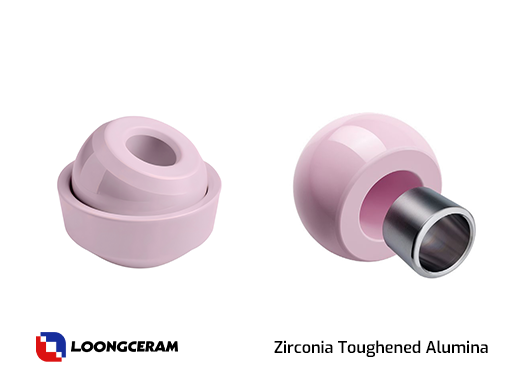Zirconia Toughened AluminaZTA
Zirconia Toughened Alumina (Al2O3-ZrO2)
Zirconia-toughened alumina (ZTA) is a composite ceramic composed of alumina and zirconia. Mixing alumina with zirconia can significantly enhance the toughness, strength, hardness and wear resistance of the material. The main factor contributing to this enhancement is a mechanism known as phase transformation toughening, which significantly improves the fracture toughness of ceramics. When subjected to stress, the crystal structure of zirconia particles changes, causing volume expansion, which helps to seal any cracks.

Material Advantages
- High performance Zirconia Toughened Alumina ceramic composite
- Use temperatures up to 1,500°C
- Chemical inertness
- Excellent wear resistance
- High bending strength
- High fracture toughness
- Excellent balance between bending strength, hardness and fracture toughness
- Sintered to near theoretical density or Hot Isostatic Pressed for enhanced reliability
- Increased tolerance to hydrothermal aging
Material grade
ZTA
Ultra Hard
General Properties
ZTA is a high performance ceramic composite and a unique ceramic material by way of exhibiting a combination of high hardness, strength, wear and corrosion resistance resulting from its Alumina content, while still maintaining reasonably high fracture toughness resulting from its Zirconia content.
Applications
- High pressure equipment – ball valve balls and seats
- Rollers and guides for metal forming
- Thread and wire guides
- Deep well down-hole valves and seats
- Shaft bearings/bushings
General Properties
CeramAlloy Ultra Hard is a high performance ceramic composite and a unique ceramic material by way of exhibiting a combination of high hardness, strength, wear and corrosion resistance resulting from its Alumina content, while still maintaining reasonably high fracture toughness resulting from its Zirconia content.
Applications
- High pressure equipment – ball valve balls and seats – particularly suitable for high flow/abrasive fluids
- Focusing nozzles for abrasive media
- Ultra high pressure pumping elements
- Deep well down-hole valves and seats
- Rollers and guides for metal forming
- Thread and wire guides
- Metal extrusion dies
Alumina Material Properties
Mechanical Properties
Thermal Properties
Electrical Properties
General Properties
| Property | Units | CeramAlloy ZTA | CeramAlloy Ultra Hard |
|---|---|---|---|
| Composition | – | Alumina/Zirconia | Alumina/Zirconia |
| Color | – | White | Off White |
| Property | Units | CeramAlloy ZTA | CeramAlloy Ultra Hard |
|---|---|---|---|
| Density | g/cm3 | 4.1 | 4.18 |
| Young’s Modulus | GPa | 335 | 350 |
| Fracture Toughness | MPa x m1/2 | 7 | 5 |
| Poisson’s Ratio | – | 0.23 | 0.22 |
| Compressive Strength | MPa | 2500 | 3000 |
| Flexural Strength | MPa | 600 | 850 |
| Hardness (Vickers 500g) | GPa | 16 | 21.5 |
| Property | Units | CeramAlloy ZTA | CeramAlloy Ultra Hard |
|---|---|---|---|
| Max Temperature (Air) | °C | 1500 | 1500 |
| Max Temperature (Inert) | °C | 1500 | 1500 |
| Coefficient of Expansion 1 | 10-6/°C | 7 | 7.5 |
| Thermal Conductivity @ 25°C | W/mK | 20 | 20 |
| Thermal Shock Resistance ΔT | °C | 200 | 200 |
1 Coefficient of Thermal Expansion (CTE) describes how the size of an object changes with a change in temperature.
| Property | Units | CeramAlloy ZTA | CeramAlloy Ultra Hard |
|---|---|---|---|
| Dielectric Strength DC @25°C | kV/mm | 16 | 16 |
| Dielectric Constant @ 1MHz | – | 10 | 10 |
| Volume Resistivity @ 25°C | Ω cm | >1016 | >1016 |
Disclaimer: The values presented are mean and typical of those resulted from test samples. They are provided as an indication only to serve as guidance in the design of ceramic components and are not guaranteed in any way. The actual values can vary according to the shape and size of the envisioned component.
Material Machining
Zirconia Toughened Alumina (ZTA) can be machined in its green (unsintered), bisque (partially sintered), or fully dense state. In the green or bisque state, ZTA can be relatively easily shaped into complex geometries. However, to achieve full densification, the sintering process causes approximately 20% shrinkage in the ZTA body. This shrinkage makes it difficult to maintain tight tolerances during pre-sintered machining.
To achieve precise tolerances, fully sintered ZTA must be machined or ground using diamond tools. This process requires the use of highly accurate diamond-coated tools or grinding wheels to shape the material to the desired dimensions. Due to the inherent toughness and hardness of ZTA, this can be a time-consuming and costly process.
To achieve precise tolerances, fully sintered ZTA must be machined or ground using diamond tools. This process requires the use of highly accurate diamond-coated tools or grinding wheels to shape the material to the desired dimensions. Due to the inherent toughness and hardness of ZTA, this can be a time-consuming and costly process.
Product application
Classified by purity
CeramicMaterials
Forming method
- Injection Molding+
- Injection Molding+
- Injection Molding+